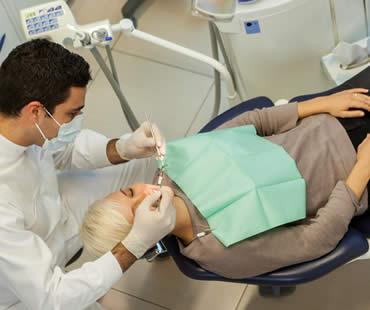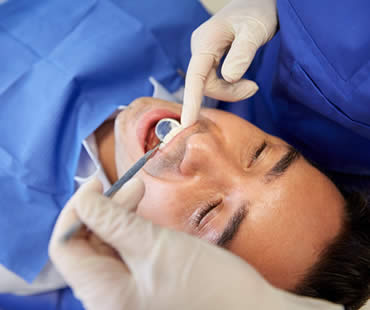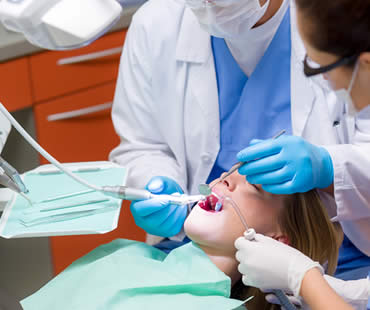
Fear and anxiety make dental treatment a challenge for many people. Sedation dentistry offers many options to help patients overcome their fears and experience a more comfortable, relaxing treatment. One of the most common options in sedation dentistry is oral conscious sedation. Here are some common questions about oral conscious sedation and answers about how it can help alleviate your stress about undergoing dental procedures:
- What is oral conscious sedation? This type of sedation utilizes a combination of pain relievers and sedatives to induce an altered state of consciousness that allows you to undergo all kinds of dental treatment in a totally relaxed and comfortable state.
- Am I asleep during the procedure? Patients who receive oral conscious sedation are drowsy but awake and able to communicate with their dental professional. This type of dental sedation allows you to be relaxed but aware.
- Will I feel pain during the dental treatment? With oral conscious sedation, you will most likely not feel any discomfort or pain.
- Is oral conscious sedation safe? While it is considered safe for most patients, your dentist will evaluate your medical and dental health to determine if you are a good candidate for oral sedation.
- Can I resume normal activity immediately after receiving oral sedation? Because you may still be slightly drowsy and under the effects of the medication, it is advised that you arrange to have a friend or family member drive you home after treatment.
- Will I have bad memories of my dental treatment? With oral conscious sedation, you will feel completely relaxed and have little to no memory of your dental procedures.
Thanks to sedation dentistry options like oral conscious sedation, you no longer have to dread or postpone necessary dental treatment due to fear and anxiety. Contact your dentist to find out how they can help you conquer your fears and restore your oral health with this gentle approach to dentistry.
Schedule your appointment at our Ottawa dental office

Sedation dentistry is designed mainly to focus on patients experiencing fear and anxiety related to dental treatment; however, it is also an excellent choice for other patient types. Following are the main groups who experience relief and comfort from sedation dentistry:
- Patients experiencing anxiety and fear or a dental phobia
- Patients possessing an acute gag reflex
- Patients who have special needs
- Patients with physical issues that affect movement
- Anxious or fearful pediatric patients
Dental professionals want a patient to be as stress-free as possible immediately prior to and during a dental visit. Relieving anxiety and fear can turn an unpleasant, stressful experience into a comfortable visit, resulting in a desire to continue dental health and hygiene by returning for regular examinations and procedures.
An acute gag reflex can leave a patient concerned about vomiting during a dental procedure; in fact, many procedures such as taking impressions or working on the back teeth may be impossible. Sedation dentistry helps patients greatly reduce this gag reflex issue, as it is often exacerbated by anxiety and fear.
Patients who have special needs related to autism, Down Syndrome, or a mental or emotional problem may have real difficulty during dental visits. Other patients may deal with physical conditions such as cerebral palsy, Parkinson’s disease, or other disorders of the central nervous system. Patients in this group may have difficulty following instructions or remaining still. Sedation dentistry solves issues of involuntary muscle movements, allowing the dentist to safely and quickly complete treatment.
Fearful children can be problematic for dentists. Children who cannot be still, comply with instructions, or stop crying can cause time-consuming safety issues. Sedation dentistry allows a dentist to perform treatments without physical restraints that could cause emotional trauma to the child, leading to adult dental phobias and fears.
Visiting the dentist and caring for your dental health should be comfortable. Contact our dental office to see what can be done to make your visit as stress-free as possible using sedation dentistry in Ottawa.

Sedation dentistry is often hailed as a solution to all of a patient’s problems regarding dental therapies. It can address anxiety, fear, stress and pain. It can provide a comfortable experience for the dental patient, allowing the dental professional to work safely and quickly. As with any pharmacological agent, there are risks, and before you agree to any sedation dentistry option, it is smart to educate yourself about some of those risks.
While single doses of oral sedatives such as Valium or Halcion are unlikely to harm a patient, there are concerns regarding multiple doses of these drugs that could potentially cause a patient to be overly sedated, or even completely unconscious. Because each patient has a different metabolism, drugs can take between twenty minutes and an hour to become fully effective.
These time-delay issues are not problematic for inhaled sedation or for IV sedation, as these types of sedation dentistry are effective almost instantaneously. For oral sedation, however, a dentist who administers more than one pill could cause an overdose if the medicine kicks in at the same time. Most dentists lack both the equipment and the training to effectively and quickly address an overdose in a patient who is unconscious.
In 2000, a group known as the Dental Organization for Conscious Sedation was launched. Its purpose is to train dentists on sedation dentistry methods such as how to properly monitor a patient during a dental procedure to ensure that their heart rates and oxygen levels are healthy. Despite this, there are still concerns about adverse effects of adults with oral conscious sedation. There have been no reported adult deaths from overdosing; however, some children have died from oral sedation, leading to the practice being recommended only for adults.
If you are about to undergo a prolonged dental procedure, or if you are considering sedation dentistry to address personal anxiety or a dental phobia, look for a dentist who has received training in sedation dentistry and has high levels of experience to ensure that your procedure is as safe and comfortable as possible.
Our dental office is located in Ottawa

Sedation dentistry, also known as “sleep dentistry,” refers to the practice of calming and relaxing a patient prior to a dental procedure with the use of pharmacological agents. Sedation dentistry began in the late 1700s when a chemist named Humphry Davy began experimenting with inhaled gasses and first observed the analgesic effects of nitrous oxide, commonly known as “laughing gas,” on himself and on dental patients.
In 1844, an American dentist named Horace Wells used nitrous oxide as a dental anesthetic during the extraction of his own molar tooth. Wells made the observation that while he experienced very little pain while undergoing the extraction, he was still fully conscious during the procedure. A few years later, dentist William Morton and surgeon John Warren performed a public oral surgery at Harvard University, demonstrating the analgesic properties of a sulfur-ether compound, further proving that sedation dentistry should be explored further.
For years, trial and error procedures informed doctors of the safety of various levels of pain-relieving gasses. It was discovered that 100% nitrous oxide, when used in prolonged dental cases, could lead to hypoxia, a condition in which the body is deprived of the oxygen it needs to thrive, something that can eventually lead to death. Finally, a Chicago surgeon named Dr. Edmund Andrews began mixing nitrous oxide with oxygen, administering them simultaneously. This allowed for safer analgesic options for both surgical and dental procedures. Ether and chloroform, combined with some nitrous oxide, was later shown to provide deeper sedation for prolonged treatments.
Intravenous (IV) sedation began in the 1960s at the Loma Linda University School of Dentistry in California. Dentists there experimented with IV sedation for the highest level of management for pain, anxiety and fear for dental patients undergoing surgery.
Today, dentists routinely turn to sedation dentistry for their patients to relieve pain, stress and to provide the most comfortable dental therapies as possible. Talk to your dentist to discover the latest sedation dentistry options and to see how they can help you positively experience your next dental procedure.
If you need a dentist in Ottawa contact us today





